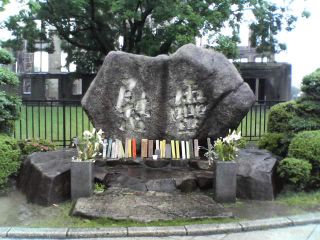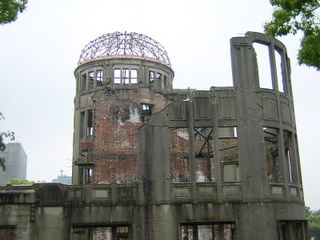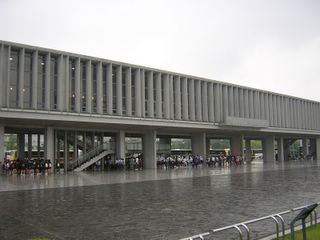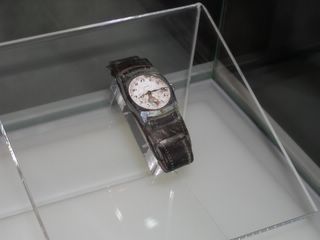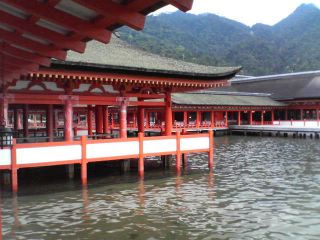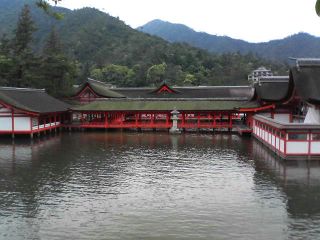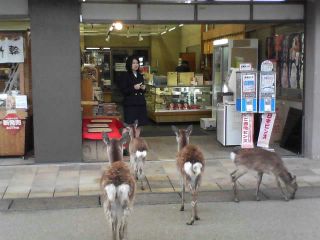Below are pictures from the Hiroshima Peace Park that leads up to the Atomic Bomb Museum. The peace park has many different memorials. It was very rainy on the day that we went there, with standing rain water on the ground that made all of our pant bottoms wet, so we had to seek dry refuge in the museum. The pictures still came out nice though. Enjoy!
B.E.W.
"We are fools whether we dance or not, so we might as well dance." - Japanese Proverb
Sunday, May 28, 2006
Saturday, May 27, 2006
Hiroshima Atomic Bomb Museum (原爆博物館)
What follows are pictures from inside the Hiroshima Atomic Bomb Museum. Up above you can find pictures from the peace park area.
The A-Bomb Museum and Peace Park area opened on August 24, 1955. The museum was significantly renovated and expanded in 1981, however, due to criticism that the previous exhibitions victimized Japan and downplayed the country's wartime aggression. Thus, 1981 saw the inclusion of a series of wall panels that illustrate Japan's aggression in the Pacific leading up to and during WWII. Steps were also taken to make the museum less graphic in nature and more accessible for younger audiences.
Indeed, the only corridor in the entire museum that comes close to being called "graphic," is merely a representation of a burned out building with painted manikins playing the role of the victims. Other than that, and a few glass cases that house hair and fingernail remnants, the museum is entirely historical.
In July 1995, a 50th anniversary exhibition of WWII A-Bomb artifacts from Hiroshima and Nagasaki was planned at the Smithsonian, however, fierce protests by US veterans and others forced the cancellation of the exhibition. To this day, the atomic bomb museums in Hiroshima and Nagasaki are the only places to see such artifacts in the world.
Adjacent to the A-Bomb Museum is the slightly different "Heiwa" or Peace Museum. This museum documents the continued effort of social advocacy groups within Japan to bring about the end of nuclear arms possession and proliferation worldwide.
While in the aforementioned "graphic" burned out building hallway in the A-Bomb museum, I found myself packed in with Japanese grade school students and laregely unable to move. One Japanese kid, a young boy to my right spotted the newest addition to my ever elongating cell phone strap, the NTT DoCoMo mushroom mascot (think Toad from Super Mario Bros.), and started commenting on it to his friends in Japanese. I struck up a conversation with him, and soon his friends all encircled me in order to catch a glimpse of the gaijin who could speak Japanese. The boy looked me in the eyes and asked me in Japanese what I thought about the A-Bomb.
I was already emotionally weakened by the museum and the sheer gravity of being in Hiroshima (it always affects me very strongly). I talked emotionally for a good three or four minutes and told him my opinion, saying that not every American agrees with the actions of wartime governments, and calling the bombings "saiyaku" (the worst) and dai-shippai (a massive failiure). I didn't cry, but my eyes did get moist. He smiled. I smiled back.
Next, he produced a folded up piece of paper from his pocket and upon making a mark with his pencil, shouted, "Hey, it's over there, there's nobody in front of it now," and darted off with his friends in tow, saying a passing "arigato" in my general direction. It was all for a museum scavenger hunt and that little kid played me like a harp.
I continued downstairs to the special exhibition of artwork and black and white pictures from the bombing. I spent a while there looking at all the pictures and all the horror. I left the museum feeling very sad as expected.
B.E.W.
The A-Bomb Museum and Peace Park area opened on August 24, 1955. The museum was significantly renovated and expanded in 1981, however, due to criticism that the previous exhibitions victimized Japan and downplayed the country's wartime aggression. Thus, 1981 saw the inclusion of a series of wall panels that illustrate Japan's aggression in the Pacific leading up to and during WWII. Steps were also taken to make the museum less graphic in nature and more accessible for younger audiences.
Indeed, the only corridor in the entire museum that comes close to being called "graphic," is merely a representation of a burned out building with painted manikins playing the role of the victims. Other than that, and a few glass cases that house hair and fingernail remnants, the museum is entirely historical.
In July 1995, a 50th anniversary exhibition of WWII A-Bomb artifacts from Hiroshima and Nagasaki was planned at the Smithsonian, however, fierce protests by US veterans and others forced the cancellation of the exhibition. To this day, the atomic bomb museums in Hiroshima and Nagasaki are the only places to see such artifacts in the world.
Adjacent to the A-Bomb Museum is the slightly different "Heiwa" or Peace Museum. This museum documents the continued effort of social advocacy groups within Japan to bring about the end of nuclear arms possession and proliferation worldwide.
While in the aforementioned "graphic" burned out building hallway in the A-Bomb museum, I found myself packed in with Japanese grade school students and laregely unable to move. One Japanese kid, a young boy to my right spotted the newest addition to my ever elongating cell phone strap, the NTT DoCoMo mushroom mascot (think Toad from Super Mario Bros.), and started commenting on it to his friends in Japanese. I struck up a conversation with him, and soon his friends all encircled me in order to catch a glimpse of the gaijin who could speak Japanese. The boy looked me in the eyes and asked me in Japanese what I thought about the A-Bomb.
I was already emotionally weakened by the museum and the sheer gravity of being in Hiroshima (it always affects me very strongly). I talked emotionally for a good three or four minutes and told him my opinion, saying that not every American agrees with the actions of wartime governments, and calling the bombings "saiyaku" (the worst) and dai-shippai (a massive failiure). I didn't cry, but my eyes did get moist. He smiled. I smiled back.
Next, he produced a folded up piece of paper from his pocket and upon making a mark with his pencil, shouted, "Hey, it's over there, there's nobody in front of it now," and darted off with his friends in tow, saying a passing "arigato" in my general direction. It was all for a museum scavenger hunt and that little kid played me like a harp.
I continued downstairs to the special exhibition of artwork and black and white pictures from the bombing. I spent a while there looking at all the pictures and all the horror. I left the museum feeling very sad as expected.
B.E.W.
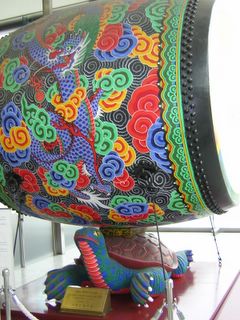
Here is a colorful turtle supporting a giant taiko drum on his back. This piece is in the entryway to the A-Bomb Museum. There are several installation art pieces like this in the entry area (another one is a giant tapestry of camels marching through the desert) that beg the question, "how do these relate to anything?"
Itsukushima Shrine (厳島神社)
Itsukushima Shrine is located on Miyajima Island (a 15 minute ferry boat ride from Hiroshima). Miyajima island (宮島) is one of the three most beautiful areas in Japan, and a picture of the floating torii gate is a staple for any guidebook or Japanese travel website.
Itsukushima Shrine was built in 593 and expanded to its current size in 1168. It is said to be the oldest shrine of its kind in the world. It is unique in that, as the tide goes in and out, the torii gate and shrine buildings themselves are partially submerged in water, creating the effect that all the buildings are floating in the sea. The torii gate is also said to be the oldest gate of its kind in the world.
Miyajima Island reminded me a lot of Catalina Island in California. It had that same small-town touristy feel (minus all the golf cart driving seniors). Miyajima is mostly a few streets with lots of gift shops (there weren't too many restaurants). There are mountain paths that you can hike to see the scenic views. I took a rain check due to the pouring rain (no pun intended). There is literally NOTHING to do on the island past 7 o'clock at night.
The ryokan (traditional Japanese inn) that we stayed in was sub-par. The food was pleasing to the eye but not to the pallette (I felt sick after eating both dinner and breakfast). Also, the bath was not impressive either. Oh well, you get what the Bings' pay for.
The weather was cloudy with lots of rain when we were in Miyajima, but the beauty of the scenery still comes through in the pictures below. I can only imagine how nice the beach would be in the summer for a bonfire with friends, and how beautiful the multi-colored leaves must be in the fall.
B.E.W.
Itsukushima Shrine was built in 593 and expanded to its current size in 1168. It is said to be the oldest shrine of its kind in the world. It is unique in that, as the tide goes in and out, the torii gate and shrine buildings themselves are partially submerged in water, creating the effect that all the buildings are floating in the sea. The torii gate is also said to be the oldest gate of its kind in the world.
Miyajima Island reminded me a lot of Catalina Island in California. It had that same small-town touristy feel (minus all the golf cart driving seniors). Miyajima is mostly a few streets with lots of gift shops (there weren't too many restaurants). There are mountain paths that you can hike to see the scenic views. I took a rain check due to the pouring rain (no pun intended). There is literally NOTHING to do on the island past 7 o'clock at night.
The ryokan (traditional Japanese inn) that we stayed in was sub-par. The food was pleasing to the eye but not to the pallette (I felt sick after eating both dinner and breakfast). Also, the bath was not impressive either. Oh well, you get what the Bings' pay for.
The weather was cloudy with lots of rain when we were in Miyajima, but the beauty of the scenery still comes through in the pictures below. I can only imagine how nice the beach would be in the summer for a bonfire with friends, and how beautiful the multi-colored leaves must be in the fall.
B.E.W.
Fun in picture form!
Here are some random and fun pictures from Hiroshima and Miyajima Island that didn't really fit into the other more serious categories up above. Enjoy! Japan has weird and interesting items on every street corner; you just have to keep your eyes open.
B.E.W.
B.E.W.

Here are some cute stone guys. There were a bunch of these guys in a row. They are in front of a shop on Miyajima Island that sells all sorts of straps and figurines featuring these characters. I was told that these little stone monk kids are very famous. Several of the girls bought cell phone straps with these guys on them. I declined.
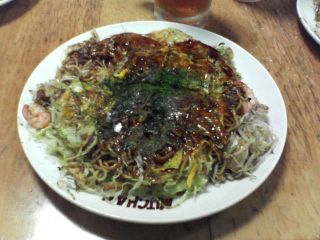
Here is a picture of the Hiroshima-yaki we had for lunch. While much like the well known Okonomiyaki (Japanese style pancake / pizza that has literally everything but the kitchen sink mixed into it), Hiroshima-yaki differs in that it uses yakisoba noodles instead of a fluffy egg batter as the culinary glue that holds the whole dish together. Our 'yaki had been sitting out for a good while before we all arrived at the small hole-in-the-wall eating place (we were late). Consequently, my 'yaki was cold and I felt quite ill after finishing it.
Thursday, May 25, 2006
So I'm off to Hiroshima...
I hope to update you all soon about my trip to Tokyo to visit Columbia Music Entertainment or, more appropriately described as, "When you're being grilled by a boardroom full of Japanese executives, if you don't know what's going on, you'd better improvise!"
In the meantime, I will be heading down south to spend the weekend in Hiroshima and Shikoku on the coattails of everyone’s favorite mega millionaire philanthropist family The Bings! This will be my second trip to Hiroshima. Hiroshima is a place (along with Auschwitz) that I firmly believe everyone should visit in their lifetime if they have the opportunity. Hiroshima is of course now a modern and beautiful city, but it stands (as it should) as a powerful reminder that we have within our hands the power to end human existance through war, prejudice, and hate. The Spiderman comics say it best; "With great power comes great responsibility." Let’s make an effort, all of us, to love, laugh, befriend, and bring joy to this world and all those around us. If you see some way that you can help someone out, even if it’s the littlest thing, don’t hesitate even for a moment, make it happen.
Till next time - I hope you all have a wonderful weekend.
B.E.W.
In the meantime, I will be heading down south to spend the weekend in Hiroshima and Shikoku on the coattails of everyone’s favorite mega millionaire philanthropist family The Bings! This will be my second trip to Hiroshima. Hiroshima is a place (along with Auschwitz) that I firmly believe everyone should visit in their lifetime if they have the opportunity. Hiroshima is of course now a modern and beautiful city, but it stands (as it should) as a powerful reminder that we have within our hands the power to end human existance through war, prejudice, and hate. The Spiderman comics say it best; "With great power comes great responsibility." Let’s make an effort, all of us, to love, laugh, befriend, and bring joy to this world and all those around us. If you see some way that you can help someone out, even if it’s the littlest thing, don’t hesitate even for a moment, make it happen.
Till next time - I hope you all have a wonderful weekend.
B.E.W.

Here is a weird house straight out of The Blair Witch Project near Kyoto University. It would be killer for a Halloween haunted house don't you think? They supposedly do a lot of live music in front of this place, but the only act going when I parked my bike was a solitary girl holding an electronic tuner in one hand and blowing the same repeated note on her french horn with the other. Shikata ga nai ne.
Wednesday, May 24, 2006

My friend Kevin told me that they didn't have these in Japan. WRONG! This is where I ate lunch before my meeting, because it was super close and I was already strapped for time due to multiple transportation misfortunes. Plus, I love Subway! I was totally looking forward to my favorite Chipotle Cheese Steak sandwich, but they don't have that kind in Japan. I had to settle for a cream cheese and grilled chicken sub instead.
Tuesday, May 23, 2006
KANPAI!!! Or Cheers (乾杯)
I once commented to my host father that Asahi Superdry was the king of Japanese beers in my mind. Last Monday marked an adventure in alcoholism one month in the making since that very comment. My host dad Katsuhiro and I hopped a bus and headed downtown to the Asahi Beer Restaurant to drink like there was no tomorrow. My host dad was dressed in a really interesting brownish-yellow suit that made him look like Colonel Mustard from Clue. In the sea of black suits I would soon be swimming in, my jeans and pink polo shirt had gaijin written all over them.
The Asahi building houses a regular brewery style restaurant on the bottom floor and a larger banquet room for special events on the second floor. Since the doorman knew my host dad by name, I figured correctly that we would forgo the formalities and head straight up to our malt liquor castle in the sky. Little did I know that we would soon be joined by forty or so of my host father’s work colleagues (all male). There was no name tag for me so I had to write my own name in Japanese on a slip of white paper. I then had to sign my name vertically in the guest book. The greeter was afraid that I couldn’t do it so he kept turning the book horizontally until I told him that I wasn’t drunk yet and could manage.
I had previously thought that my host father was Yakuza (Japanese mafia), because my family has a lot of money and I never saw him wear any short sleeve shirts (a sure fire sign to me that his body was covered with licentious tattoos). As it turns out however, he works for a venture capital company, and specializes in computers, though he quickly points out jokingly that he knows nothing about how computers work. I figure he must be pretty darn high up in the company by the number of people that came over to introduce themselves to him throughout the evening.
My evening, which lasted from 7 PM till 2 AM was a fantastic opportunity to test how much I could actually drink before death set in (I had always been wondering).
The Japanese drink their favorite crisp, cool nama (draft) beer in what are called “jokki” ("joke-y") or big beer mugs. These mugs come in three sizes: Housewife, college student, and businessman. The largest businessman sized jokki holds about three beers. Beer runs as thick as blood in the veins of the average Japanese company worker. Just for comparison to American fathers, my Japanese host dad loves Asahi Beer so much that he not only gave me an Asahi polo shirt and key chain (two items out of his massive Asahi paraphernalia collection), but he also has a keg as a permanent installation in his room at home for when the boys come over.
I began drinking beer as the night began and found my favorite Superdry to be as delicious as ever. Several members from my host dad’s company came up and gave speeches at the microphone, welcoming everybody, and extending wishes for continued success. I was quite happily guzzling jokkis of beer, when my host dad politely told me that I shouldn’t drink while the company heads were speaking. I swear I saw at least four other guys doing it though. After each speech we would all stand around the rectangular table formation as if we were at a cult meeting as the person at the microphone would bark out “XXXXX KANPAI!!!!!” We would all respond by screaming KANPAI!!!! and downing the rest of our mug. Examples include:
“Suteki na kanojo wo sagasu KANPAI!!!” – “For finding a sexy girlfriend…KANPAI!!!”
- An individual kanpai that I shared with a 20-something business man.
OR
“Motto beer wo nomou KANPAI!!!” - “For drinking more beer…KANPAI!!!”
- Yelled by a drunk guy a good way into the evening.
Thanks to the amazing service staff, by the time I finished one of my jokkis, another full one was already waiting. About halfway through the evening, representatives from Asahi Beer came to join our party and gave us cans of Prime Time, an Asahi brand that has not yet hit the shelves. My host dad, who was already several mugs ahead of me by this point, would mime shoving the can underneath his jacket and laugh hysterically as he said we should smuggle them out. The Asahi rep (always concerned about his customer’s opinions) went around and individually asked everyone in the room what they thought of the new beer. I said it tasted fine, but just about everyone else gave him nothing but criticisms of the “disgusting” flavor as his reddening face dripped beads of sweat.
I was told that there was going to be food to counteract the effects of the massive alcohol intake. To be fair, there was food, however Japanese delicacies like sliced raw fish and tofu don’t exactly fill you up when you are drinking nothing but beer. Throughout the evening there were no water glasses and no alternatives to do anything but drink. Because of this, the group got progressively more and more rowdy and incoherent.
As the night progressed I quickly lost count of my intake. There’s a hierarchy of words to describe being tanked, smashed, or wickedly f*cked up in Japanese. The highest word is “beron beron.” I wasn’t quite beron beron yet when I started making some interesting cultural observations in between trips to the bathroom:
1) Japanese businessmen like to rub each other when drunk. This isn’t a sexual rubbing; rather, it most closely mimics how a trainer would rub his prize fighter’s shoulders as he rests in the corner between rounds. There’s nothing you can do to avoid this. As the drunken men circled the room, regardless of whether they had met me or not, I would get the boxer's rub. At one point I recall seeing my host father cradling another man in his arms as he laughed and whispered in his ear.
2) The greatest practical joke in the world is a foreigner who can speak Japanese. I cannot tell you how many times my host dad nearly collapsed to the floor in fits of laughter upon playing out his favorite put over. Whenever a businessman would come over to bow deeply to my host father, that same businessman would simultaneously have to make a decision as to if he wanted to engage the already visibly incoherent gaijin or not. If he chose to do so, he would nervously say “Hello” or “Hajimemashite” to me while presenting his business card (I now have a stack of these from people I cannot remember meeting). Even as drunk as I was, I could still muster “Hi, I’m Ben, nice to meet you” in Japanese. Regardless of the businessman’s reaction to my utterance, my host father would burst out with tears of laughter saying, “Bet you didn’t think he could speak Japanese - BAH HAH HAHA.” He would then tell the business man that I was “his son” (referring to my status in the host family) and make a joke about sleeping with another woman.
3) My Japanese doesn’t get better when I drink – I simply don’t care as much about the mistakes I make. At one point I remember a gray haired businessman telling me all about his motorbike tours around the mountains. At that point my eyes were creating a nifty strobe light effect and my face felt like it was modeler’s clay. I watched, almost outside of myself, as his Japanese words shot by my ears as incomprehensible projectiles. I remember smiling and nodding a lot and saying, “uh huh, uh huh." I also remember that I really wanted to participate in the conversation so I took it upon myself to comment on whatever individual vocabulary words I could identify from his lecture. For instance, if he said, “And when I took the bike up past 50 around the winding lake road, you wouldn't believe the view of the sunset!” I would respond with something along the lines of, “lakes are filled with water.”
4) In a land where public humiliation is worth its weight in gold, I am King Midas. I was in the bathroom when I heard my name being called over the microphone. I knew that the minute I left the safety of my heated Toto washlet, I would be fair game. Pairs of hands ushered me up to the microphone (probably a good idea because I couldn’t walk too well) as I tried to say “this is a bad idea” in Japanese. I had given away the fact that I could speak Japanese by enacting my father’s practical joke to virtually everyone in the room, so now it was time for me to deliver a speech in front of the now 50 or so stinking drunks (myself included) in the room.
My first line was killer (you’ll have to imagine my drunken Japanese voice): “I’m really tanked, so I’m not sure if you’re gonna be able to understand me or not.” This line produced a lot of laughs. After that, I rambled incoherently in a mishmash of honorific Japanese as I tried to wholeheartedly express my gratitude for the invitation and the experience. I ended with a kanpai to “yukoh” or friendship and watched as my host dad drained his jokki in three seconds flat.
I eventually was taken home in a taxi by one of my host father’s colleagues who lives nearby. My host dad would continue to drink through the morning with his buddies and not come home (something that angered my host mom). My chaperone initially took me to another bar to drink more, but when I truthfully told him that I had had enough, we went back to my house.
I made it to school the next morning with the worst hangover of my life. I rode the bus (standing room only), because biking was out of the question, and it was all I could do to hold it together as the cabin swung back and forth. It became a personal goal of mine not to defile the middle school girl text messaging on her cell phone in front of me.
Once at the center, I found that if I sat perfectly still on the couch with my mouth slightly eschewed and a can of closed Candian Dry Ginger Ale positioned in my right hand, I could avoid the urge to blow chunks. Once in the classroom however, I got severe motion sickness as I tilted my head downwards to read the newspaper article positioned on the table. I took the article slow, one character at a time, like I was a Japanese preschooler.
Somehow the word must have got around that I was hung-over - maybe the fact that I was stoically sucking on a lemon wedge gave me away (the lemon was my host mom’s surefire remedy). Please remember for the future, when one of your friends is visibly exerting every ounce of their strength to not throw up, it is of the utmost importance that you ask them repeatedly, “Hey, do you have a hangover? Huh? Do ya?”
I got better as the day got longer. At one point my host mom called the center to ask if I was alright (she didn’t seem that concerned when I left the house gagging in the morning). All the ladies who work in the office then took turns laughing and gabbing about how I was “yowai” or weak when it came to alcohol. Ah well, I deserved it I guess. While drinking, I asked my host father if this get-together was a special event because of all the people that were present. He told me that these nomikai or drinking parties happen every month. So, there’s always next month!
KANPAI!!!
B.E.W.
The Asahi building houses a regular brewery style restaurant on the bottom floor and a larger banquet room for special events on the second floor. Since the doorman knew my host dad by name, I figured correctly that we would forgo the formalities and head straight up to our malt liquor castle in the sky. Little did I know that we would soon be joined by forty or so of my host father’s work colleagues (all male). There was no name tag for me so I had to write my own name in Japanese on a slip of white paper. I then had to sign my name vertically in the guest book. The greeter was afraid that I couldn’t do it so he kept turning the book horizontally until I told him that I wasn’t drunk yet and could manage.
I had previously thought that my host father was Yakuza (Japanese mafia), because my family has a lot of money and I never saw him wear any short sleeve shirts (a sure fire sign to me that his body was covered with licentious tattoos). As it turns out however, he works for a venture capital company, and specializes in computers, though he quickly points out jokingly that he knows nothing about how computers work. I figure he must be pretty darn high up in the company by the number of people that came over to introduce themselves to him throughout the evening.
My evening, which lasted from 7 PM till 2 AM was a fantastic opportunity to test how much I could actually drink before death set in (I had always been wondering).
The Japanese drink their favorite crisp, cool nama (draft) beer in what are called “jokki” ("joke-y") or big beer mugs. These mugs come in three sizes: Housewife, college student, and businessman. The largest businessman sized jokki holds about three beers. Beer runs as thick as blood in the veins of the average Japanese company worker. Just for comparison to American fathers, my Japanese host dad loves Asahi Beer so much that he not only gave me an Asahi polo shirt and key chain (two items out of his massive Asahi paraphernalia collection), but he also has a keg as a permanent installation in his room at home for when the boys come over.
I began drinking beer as the night began and found my favorite Superdry to be as delicious as ever. Several members from my host dad’s company came up and gave speeches at the microphone, welcoming everybody, and extending wishes for continued success. I was quite happily guzzling jokkis of beer, when my host dad politely told me that I shouldn’t drink while the company heads were speaking. I swear I saw at least four other guys doing it though. After each speech we would all stand around the rectangular table formation as if we were at a cult meeting as the person at the microphone would bark out “XXXXX KANPAI!!!!!” We would all respond by screaming KANPAI!!!! and downing the rest of our mug. Examples include:
“Suteki na kanojo wo sagasu KANPAI!!!” – “For finding a sexy girlfriend…KANPAI!!!”
- An individual kanpai that I shared with a 20-something business man.
OR
“Motto beer wo nomou KANPAI!!!” - “For drinking more beer…KANPAI!!!”
- Yelled by a drunk guy a good way into the evening.
Thanks to the amazing service staff, by the time I finished one of my jokkis, another full one was already waiting. About halfway through the evening, representatives from Asahi Beer came to join our party and gave us cans of Prime Time, an Asahi brand that has not yet hit the shelves. My host dad, who was already several mugs ahead of me by this point, would mime shoving the can underneath his jacket and laugh hysterically as he said we should smuggle them out. The Asahi rep (always concerned about his customer’s opinions) went around and individually asked everyone in the room what they thought of the new beer. I said it tasted fine, but just about everyone else gave him nothing but criticisms of the “disgusting” flavor as his reddening face dripped beads of sweat.
I was told that there was going to be food to counteract the effects of the massive alcohol intake. To be fair, there was food, however Japanese delicacies like sliced raw fish and tofu don’t exactly fill you up when you are drinking nothing but beer. Throughout the evening there were no water glasses and no alternatives to do anything but drink. Because of this, the group got progressively more and more rowdy and incoherent.
As the night progressed I quickly lost count of my intake. There’s a hierarchy of words to describe being tanked, smashed, or wickedly f*cked up in Japanese. The highest word is “beron beron.” I wasn’t quite beron beron yet when I started making some interesting cultural observations in between trips to the bathroom:
1) Japanese businessmen like to rub each other when drunk. This isn’t a sexual rubbing; rather, it most closely mimics how a trainer would rub his prize fighter’s shoulders as he rests in the corner between rounds. There’s nothing you can do to avoid this. As the drunken men circled the room, regardless of whether they had met me or not, I would get the boxer's rub. At one point I recall seeing my host father cradling another man in his arms as he laughed and whispered in his ear.
2) The greatest practical joke in the world is a foreigner who can speak Japanese. I cannot tell you how many times my host dad nearly collapsed to the floor in fits of laughter upon playing out his favorite put over. Whenever a businessman would come over to bow deeply to my host father, that same businessman would simultaneously have to make a decision as to if he wanted to engage the already visibly incoherent gaijin or not. If he chose to do so, he would nervously say “Hello” or “Hajimemashite” to me while presenting his business card (I now have a stack of these from people I cannot remember meeting). Even as drunk as I was, I could still muster “Hi, I’m Ben, nice to meet you” in Japanese. Regardless of the businessman’s reaction to my utterance, my host father would burst out with tears of laughter saying, “Bet you didn’t think he could speak Japanese - BAH HAH HAHA.” He would then tell the business man that I was “his son” (referring to my status in the host family) and make a joke about sleeping with another woman.
3) My Japanese doesn’t get better when I drink – I simply don’t care as much about the mistakes I make. At one point I remember a gray haired businessman telling me all about his motorbike tours around the mountains. At that point my eyes were creating a nifty strobe light effect and my face felt like it was modeler’s clay. I watched, almost outside of myself, as his Japanese words shot by my ears as incomprehensible projectiles. I remember smiling and nodding a lot and saying, “uh huh, uh huh." I also remember that I really wanted to participate in the conversation so I took it upon myself to comment on whatever individual vocabulary words I could identify from his lecture. For instance, if he said, “And when I took the bike up past 50 around the winding lake road, you wouldn't believe the view of the sunset!” I would respond with something along the lines of, “lakes are filled with water.”
4) In a land where public humiliation is worth its weight in gold, I am King Midas. I was in the bathroom when I heard my name being called over the microphone. I knew that the minute I left the safety of my heated Toto washlet, I would be fair game. Pairs of hands ushered me up to the microphone (probably a good idea because I couldn’t walk too well) as I tried to say “this is a bad idea” in Japanese. I had given away the fact that I could speak Japanese by enacting my father’s practical joke to virtually everyone in the room, so now it was time for me to deliver a speech in front of the now 50 or so stinking drunks (myself included) in the room.
My first line was killer (you’ll have to imagine my drunken Japanese voice): “I’m really tanked, so I’m not sure if you’re gonna be able to understand me or not.” This line produced a lot of laughs. After that, I rambled incoherently in a mishmash of honorific Japanese as I tried to wholeheartedly express my gratitude for the invitation and the experience. I ended with a kanpai to “yukoh” or friendship and watched as my host dad drained his jokki in three seconds flat.
I eventually was taken home in a taxi by one of my host father’s colleagues who lives nearby. My host dad would continue to drink through the morning with his buddies and not come home (something that angered my host mom). My chaperone initially took me to another bar to drink more, but when I truthfully told him that I had had enough, we went back to my house.
I made it to school the next morning with the worst hangover of my life. I rode the bus (standing room only), because biking was out of the question, and it was all I could do to hold it together as the cabin swung back and forth. It became a personal goal of mine not to defile the middle school girl text messaging on her cell phone in front of me.
Once at the center, I found that if I sat perfectly still on the couch with my mouth slightly eschewed and a can of closed Candian Dry Ginger Ale positioned in my right hand, I could avoid the urge to blow chunks. Once in the classroom however, I got severe motion sickness as I tilted my head downwards to read the newspaper article positioned on the table. I took the article slow, one character at a time, like I was a Japanese preschooler.
Somehow the word must have got around that I was hung-over - maybe the fact that I was stoically sucking on a lemon wedge gave me away (the lemon was my host mom’s surefire remedy). Please remember for the future, when one of your friends is visibly exerting every ounce of their strength to not throw up, it is of the utmost importance that you ask them repeatedly, “Hey, do you have a hangover? Huh? Do ya?”
I got better as the day got longer. At one point my host mom called the center to ask if I was alright (she didn’t seem that concerned when I left the house gagging in the morning). All the ladies who work in the office then took turns laughing and gabbing about how I was “yowai” or weak when it came to alcohol. Ah well, I deserved it I guess. While drinking, I asked my host father if this get-together was a special event because of all the people that were present. He told me that these nomikai or drinking parties happen every month. So, there’s always next month!
KANPAI!!!
B.E.W.
Sunday, May 21, 2006
Nara (奈良)
My religion class and I took a day trip to Nara today to see Todaiji Temple and the Daibutsu (Great Buddha) - not to mention all the deer! The trip was fun but a bit tiring as well.
Nara was Japan's first permanent capital (or so they hoped back in those days). The capital would later be moved to Kyoto and then to Tokyo. Nara is famous for its Shika Coen or deer park. This is actually simply the temple grounds where hundreds of deer of all walks of life roam free, nibble at your back packs and look at you with big wide deer eyes that say, "Please feed me specially formulated 150 Yen packs of deer crackers."
Some people find the deer to be traumatic because they generally chase after you and get pretty aggressive when it comes to those crackers, but I like them. Every now and then you see a mother sweep her crying kid up into her arms as the swarm of deer circle around the kid, lunging for treats, and moving in for the kill. My friend Michiko (a Kyoto University student whose auditing the class) was scared of them.
The deer are trained to bow. Sometimes you can get them to bow for their crackers like proper gentlemen. Other times they team up on you like the raptors from Jurassic Park. The 150 yen pack of crackers you hide behind your back while teasing the deer in front of you with a delicious morsel can be inhaled in an instant by one of his covert buddies without your knowledge.
In addition to the Shika Coen, there is also the Daibutsu or Great Buddha. The pictures below do a far better job of describing this amazing rendering of the Buddha than I can in this post.
After the structured course stuff, some center kids and I went to have okonomiyaki at a nearby place. It was quite yummy. After that I hopped on a train and came back to Kyoto. Class tomorrow morning. Ugh.
Next Up: Drinking with Japanese businessmen - you think I'm an alcoholic...just wait.
Stay Tuned!
B.E.W.
Nara was Japan's first permanent capital (or so they hoped back in those days). The capital would later be moved to Kyoto and then to Tokyo. Nara is famous for its Shika Coen or deer park. This is actually simply the temple grounds where hundreds of deer of all walks of life roam free, nibble at your back packs and look at you with big wide deer eyes that say, "Please feed me specially formulated 150 Yen packs of deer crackers."
Some people find the deer to be traumatic because they generally chase after you and get pretty aggressive when it comes to those crackers, but I like them. Every now and then you see a mother sweep her crying kid up into her arms as the swarm of deer circle around the kid, lunging for treats, and moving in for the kill. My friend Michiko (a Kyoto University student whose auditing the class) was scared of them.
The deer are trained to bow. Sometimes you can get them to bow for their crackers like proper gentlemen. Other times they team up on you like the raptors from Jurassic Park. The 150 yen pack of crackers you hide behind your back while teasing the deer in front of you with a delicious morsel can be inhaled in an instant by one of his covert buddies without your knowledge.
In addition to the Shika Coen, there is also the Daibutsu or Great Buddha. The pictures below do a far better job of describing this amazing rendering of the Buddha than I can in this post.
After the structured course stuff, some center kids and I went to have okonomiyaki at a nearby place. It was quite yummy. After that I hopped on a train and came back to Kyoto. Class tomorrow morning. Ugh.
Next Up: Drinking with Japanese businessmen - you think I'm an alcoholic...just wait.
Stay Tuned!
B.E.W.

Here is the largest solid wooden structure in the world - the Daibutsudan or enclosure for the Great Buddha. The picture can't really convey the size of this place. Also of note is the fact that all the wood pieces are fitted together like a puzzle, so no nails were originally used. It is truly magnificent!

Here is the money shot, the reason you come to Nara: The Daibutsu or Great Buddha. This Buddha was first errected in the 8th Century by devout Buddhist follower, Emperor Shomu. Shomu wanted to show the world that Japan was a devout Buddhist nation along the lines of China and India, and so construction began on the Buddha you see before you. The Daibutsu has since been reconstructed many times. Buddha's head has fallen off more than once during Japan's many earthquakes. He still remains as impressive as ever though.
Subscribe to:
Posts (Atom)
